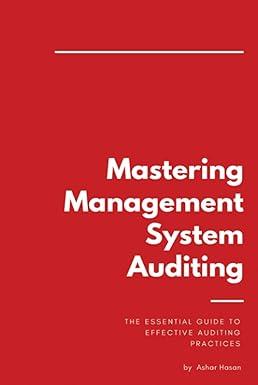Answered step by step
Verified Expert Solution
Question
1 Approved Answer
CASE 8.1 ACTIVITY-BASED ANALYSIS AND BUDGETING. Doubtfire Press produces children's books for national distribution through mainstream distributors such as Baker and Taylor. It has recently



CASE 8.1 ACTIVITY-BASED ANALYSIS AND BUDGETING. Doubtfire Press produces children's books for national distribution through mainstream distributors such as Baker and Taylor. It has recently decided to implement activity-based analysis and ABB to help it gain control over its publication costs. There are a number of activities and professionals involved in publishing a children's book, as summarized in the table below. Individual Writer Illustrator Designer Activity Writes the 32 pages of storyline Creates the art for the book Combines the word and art to make a digital file Takes the digital file and prints books Organizes the publication process Offers the book to the distribution network Sells the book to the market Printer Publisher Distributor Retailer This list of people make up the value chain for the children's book industry. Doubtfire ha own set of writers, illustrators, and designers. It is also the printer and publisher of the books, Kav Doubtfire, the company's owner, describes the process: We first need a good story line. This can come from one of our current authors or may be a new acquisition. Once the story line is set the designer lays out the page so the illustra- tor knows what spaces need to be filled in. The project then goes into the art stage, which normally takes about a month for a standard 32-page book. The artist and designer are working in tandem during this period. Once the artwork is done, it has to be digitized. The designer does this using special equipment to scan the work into high-resolution files. The designer then combines the text and the artwork into one, ready-to-print file. The digital file is sent off to the printer, who puts the book in the printing queue. Before the book can be printed, color proofs are generated. These are gone over in detail by the writer, illustrator, and designer to look for any final errors, color matching, and any flaws that may have crept in. Once the proofs are approved, the printing process begins. This requires printing the pages in large, multipage sheets, then folding the "signature" into pages, cutting and binding the pages into a book. Once the book is done, the publisher, who has managed the entire process, negotiates with the distributor, setting price and pro- motion guidelines. The activities, time line, and costs for these activities are in the table below. Activity Write book Design book Illustrate book Negotiate art and design Create digital files Send digital files to printer Create color proofs Duration 2 months 30 hours 1 month 40 hours 20 hours 15 minutes 2 weeks Cost $15,000 $50.00 per hour $10,000 $75.00 per hour $50.00 per hour $50.00 per hour $2,500 Duration 1 hour 1 week 1 day Activity Approve color proofs Rescan and correct proofs Create plates for printing Print pages for 5,000 books Bind pages into 5,000 books Negotiate terms with distributor Ship book to distribution warehouse Market book Cost $100.00 per hour $1,000 $1,500 $5,000 $5,000 $1,200 4 hours 8 hours 1 week 2 days 1 month $500 $12,000 Kay wants to develop a standard budget for a book using these average figures. But, given the high competition in the children's book publishing industry, she wants to carve off 15% of the total time and costs of production. Some areas she cannot touch are the artist and writer. These are standard industry fees and really are not open for negotiation. In fact, the cost and time reductions will need to come out of the production process itself, which includes design work. REQUIRED: a. Using the data provided in the table, develop a total elapsed time and total cost for producing 5,000 units of a children's book. b. What is the cost of one book in this 5,000-unit run? C. Calculate what 15% of the time and cost for the process is. Can Kay reasonably expect to remove 15% of the time and cost from this process if she cannot change her terms with her writers and illustrators? d. Of the time that is spent, what do you feel is truly value-adding, in other words, something the customer would willingly pay for? Is there enough non-value- added time and activities to meet Kay's 15% goal? Why or why not? Use a busi- ness case structure to present your argument. IN TIME Betsy Homemaker makes and distributes
Step by Step Solution
There are 3 Steps involved in it
Step: 1

Get Instant Access to Expert-Tailored Solutions
See step-by-step solutions with expert insights and AI powered tools for academic success
Step: 2

Step: 3

Ace Your Homework with AI
Get the answers you need in no time with our AI-driven, step-by-step assistance
Get Started


